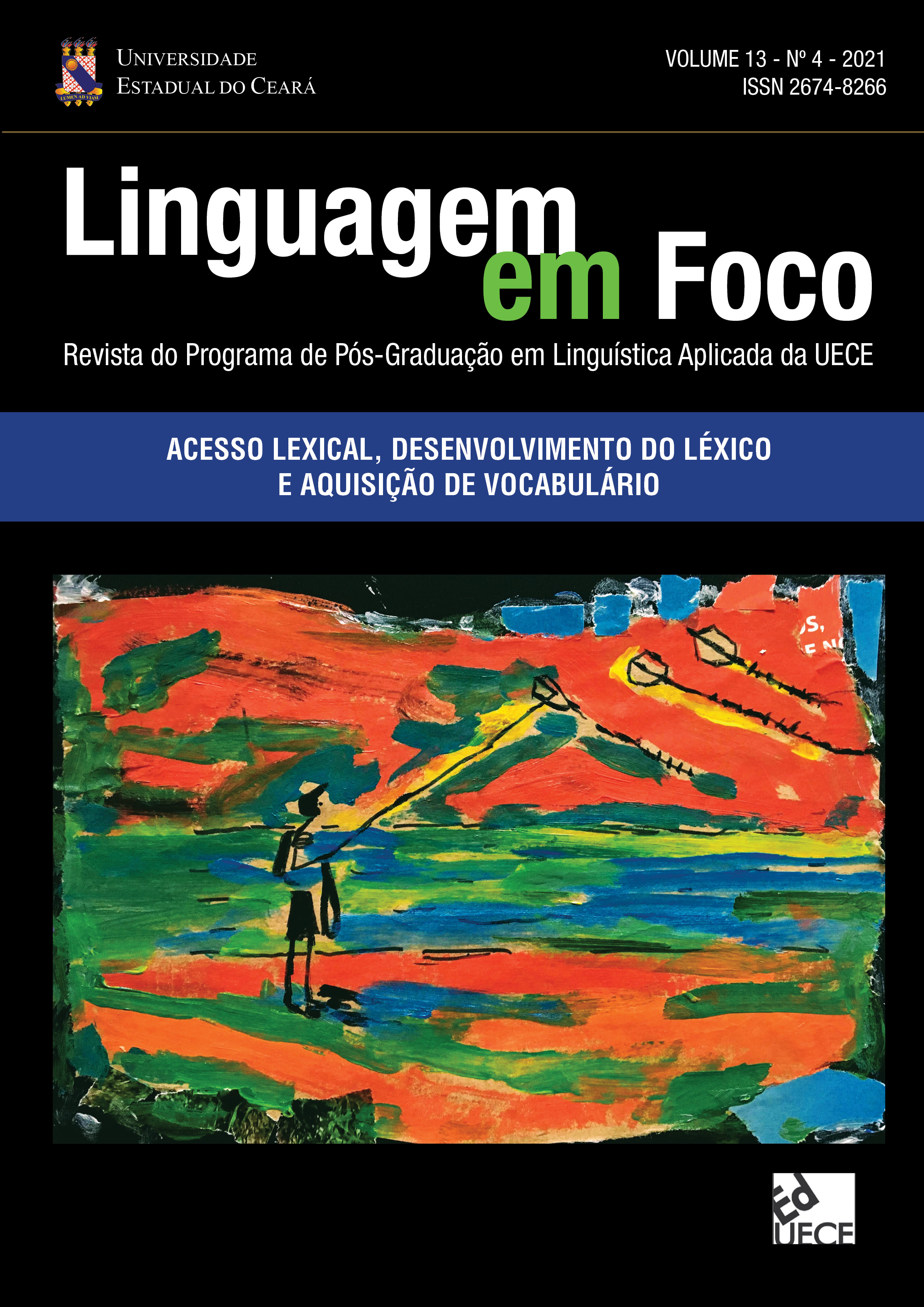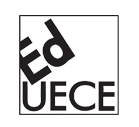Access and representation of nouns inflected by number in the Brazilian Portuguese lexicon
DOI:
https://doi.org/10.46230/2674-8266-13-7375Keywords:
Lexicon, Morphology, Number Inflexion, Brazilian Portuguese, PrimingAbstract
We seek to investigate the processes of access and representation in the mental lexicon of words inflected in number in Brazilian Portuguese. Issues related to mental lexicon theories were observed in the psycholinguistic perspective, arguing that both the access to lexical items and their representation are done through morphemes, in the so-called Full Parsing Models (TAFT; FORSTER, 1975; TAFT, 1994 ); models that postulate access and representation through whole words, the Full Listening Models (BUTTERWORTH, 1983) are also presented; and the models that present access and lexical representation through morphemes and whole words, simultaneously, depending on aspects of frequency, known as Dual-route Models (CARAMAZZA; LAUDANNA; ROMANI, 1988; SCHREUDER; BAAYEN, 1995; MIMOUNI; KEHAYA; JAREMA, 1998). Regarding BP, we carried out a study to investigate the access and storage of nominal forms inflected in number, aiming to provide data about how access and lexical representation in this language takes place. Two experiments were carried out, in which native BP speakers were tested in Covert priming tests in relation to regular and irregular forms, respectively. Regarding the results, it can be said that a significant facilitation effect between primes and targets was found under identical and plural conditions in both experiments. The results also showed a significant frequency effect. Therefore, priming effects showed significant interactions between frequency and plural types, suggesting a dual-route model (DUAL-ROUTE) in BP.
Downloads
References
BUTTERWORTH, B. Lexical Representation. In: ____. (org.) Language production: development, writing and other language processes. Londres: Academic Press, v.2, 1983.
CÂMARA JR., J. M. Estrutura da Língua Portuguesa. Petrópolis: Vozes, 1970.
CARAMAZZA, A.; LAUDANA, A.; ROMANI, C. Lexical access and inflection morphology. Cognition, v. 28, p. 297-332, abr., 1988.
CLAHSEN, H. Lexical entries and rules of language: a multidisciplinary study of German inflection. Behavioral and Brain Sciences, v. 22, p. 991-1060, 1999.
CLAHSEN, H.; BARTKE, S.; GÖLLNER, S. Formal features in impaired grammars: A comparison of English and German SLI children. Jornal of Neurolinguistics. v. 10, p. 151-171, abr./jun., 1997.
COLÉ, P.; SEGUI, J.; TAFT, M. Words and morphemes as units for lexical access. Journal of Memory and Language, p. 312-330, 1997.
CORPUS DO PORTUGUÊS: Banco de dados. Disponível em: http://www.corpusdoportugues.org. Acesso em: 01 out 2018.
FRAUENFELDER, U. H.; SCHREUDER, R. Constraining psycholinguistic models of morphological processing and representation: The role of productivity. Yearbook of Morphology, p. 165-183, 1991.
GIRAUDO, H.; GRAINGER, J. Effects of prime frequency and cumulative root frequency in masked morphological priming. Language and Cognitive Processes, v. 15, p. 421-444, 2000.
GONÇALVES, C. A. Morfologia. São Paulo: Parábola, 2019.
HENRIQUES, C. C. Morfologia: Estudos lexicais em perspectiva sincrônica. 34. ed. Rio de Janeiro: Elsevier, 2011.
LAINE, M.; VAINIO, S.; HYONA, J. Lexical access routes in morphologically rich language. Journal of Memory and Language, v. 40, p. 109-135, jan., 1999.
MARINKOVIC, K. Spatiotemporal dynamics of words processing in the human cortex. Neuroscientist, v. 10, p. 142-152, 2004.
MIMOUNI, Z.; KEHAYIA, E.; JAREMA, G. The mental representation of singular and plurals nouns in Algerian as revealed through auditory priming in agrmamatic aphasic Patiens. Brain and Language, v. 61, p. 63-87, 1998.
MONTEIRO, J.L. Morfologia Portuguesa. 4. ed. Campinas: Pontes, 2002.
PINKER, S.; PRINCE, A. Regular and irregular morphology and the psychological status of rules of grammar. Berkeley Linguistics Society, p. 230-251, 1991.
SCHREUDER, R.; BAAYEN, R.; H. Modeling morphological processing. In: FELDMAN, L. B. (ed.) Morphological Aspects of Language Processing. Lawrence Erlbaum, Hillsdale, New Jersey, p. 131-154, 1995.
SONNENSTUHL, I.; HUTH, A. Processing and representation of German -n plurals: a dual mechanism approach. Brain and language, v. 81, p. 276-290, jan., 2002.
STOCKALL, L.; MARANTZ, A. A single route, full decomposition model of morphological complexity: MEG evidence. The mental lexicon, 2006.
TAFT, M.; FORSTER, K. I. Lexical storage and retrieval of prefixed words. Journal of Verbal Learning and Verbal, v. 14, p. 638-647, dez.,1975.
TAFT, M. Interactive activation as framework for understanding morphological processing. Language and Cognitive Processes, v. 9, p. 271-294, ago., 1994.
VILLALVA, A. Estruturas Morfológicas: Unidades e hierarquias nas palavras do Português. Lisboa: Universidade de Lisboa, 1994.
WITTENBURG, P.; NAGENGAST, J.; BAUMANN, H. NESU - The Nijmegen experiment setup. In: TRAPP, A.; HAMMOND, N.; MANNING, C. (Eds.). CIP98 conference proceedings, p. 92-93, York, England: CTI Centre for Psychology, 1998.
Published
How to Cite
Issue
Section
License
Copyright (c) 2022 Jefferson Alves da Rocha, José Ferrari Neto

This work is licensed under a Creative Commons Attribution 4.0 International License.
Authors who publish in Linguagem em Foco Scientific Journal agree to the following terms:
- Authors retain the copyright and grant the journal the right of first publication. The articles are simultaneously licensed under the Creative Commons Attribution License which allows sharing the work with an acknowledgement of its authorship and initial publication in this journal.
- The concepts issued in signed articles are the absolute and exclusive responsibility of their authors. Therefore, we request a Statement of Copyright, which must be submitted with the manuscript as a Supplementary Document.
- Authors are authorized to make the version of the text published in Linguagem em Foco Scientific Journal available in institutional repositories or other academic work distribution platforms (ex. ResearchGate, Academia.edu).





























